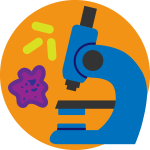Tracking Gorillas Can Get Hairy
George Amato wants to learn more about the endangered eastern lowland gorilla. He travels to wildlife preserves in Africa to collect DNA samples from these magnificent primates. Studying gorilla DNA gives many answers about the animal's biology and habitat. To collect DNA, George has to tackle a 450-pound gorilla. Right? Nope! Like cats and dogs, gorillas shed their hair. By studying the DNA from these stray hairs, George can determine where the gorillas are living within the wildlife park. He discovered that the gorilla groups were not moving from one end of the park to the other. This means that gorillas that live at one end of the park never have the chance to breed with the gorillas that live on the other side. He suspected that this isolation of gorilla groups was a result of human activity in the center of the park. So he recommended that the park rangers limit the amount of human activity within the park in hopes that this would encourage the groups of gorillas to mix with each other. George to the rescue!
Hometown: Milford, Connecticut
Position: molecular biologist at the Wildlife Conservation Society and the American Museum of Natural History
Education: B.S., University of Connecticut; Ph.D., Yale University
Known for: molecular biology studies of the eastern lowland gorilla and the Yacare caiman

George Amato is passionate about the Yacaré caiman. What is it?
a protected plant related to bananas
a protected reptile related to the crocodile
a scary amusement park ride
Correct!
In a 1993 court case, George used DNA evidence to protect the caimans' rights by exposing people who poach or hunt them for their skins.
George helped the U.S. Fish and Wildlife Service catch a smuggler who was trying to sneak shoes made with protected reptile skins.
Fact
George took samples of DNA from the shoes and handbags and determined that they were made from a protected species.
Genetic research helps an endangered animal in many ways. We only need a small sample of its hair or skin to study its DNA. We don't need to capture it.





 Biodiversity
Biodiversity
 Brain
Brain
 Genetics
Genetics
 Marine BiOLogy
Marine BiOLogy
 MicrobiOLogy
MicrobiOLogy
 PaleontOLogy
PaleontOLogy
 ZoOLogy
ZoOLogy
 AnthropOLogy
AnthropOLogy
 ArchaeOLogy
ArchaeOLogy
 Astronomy
Astronomy
 Climate Change
Climate Change
 Earth
Earth
 Physics
Physics
 Water
Water
